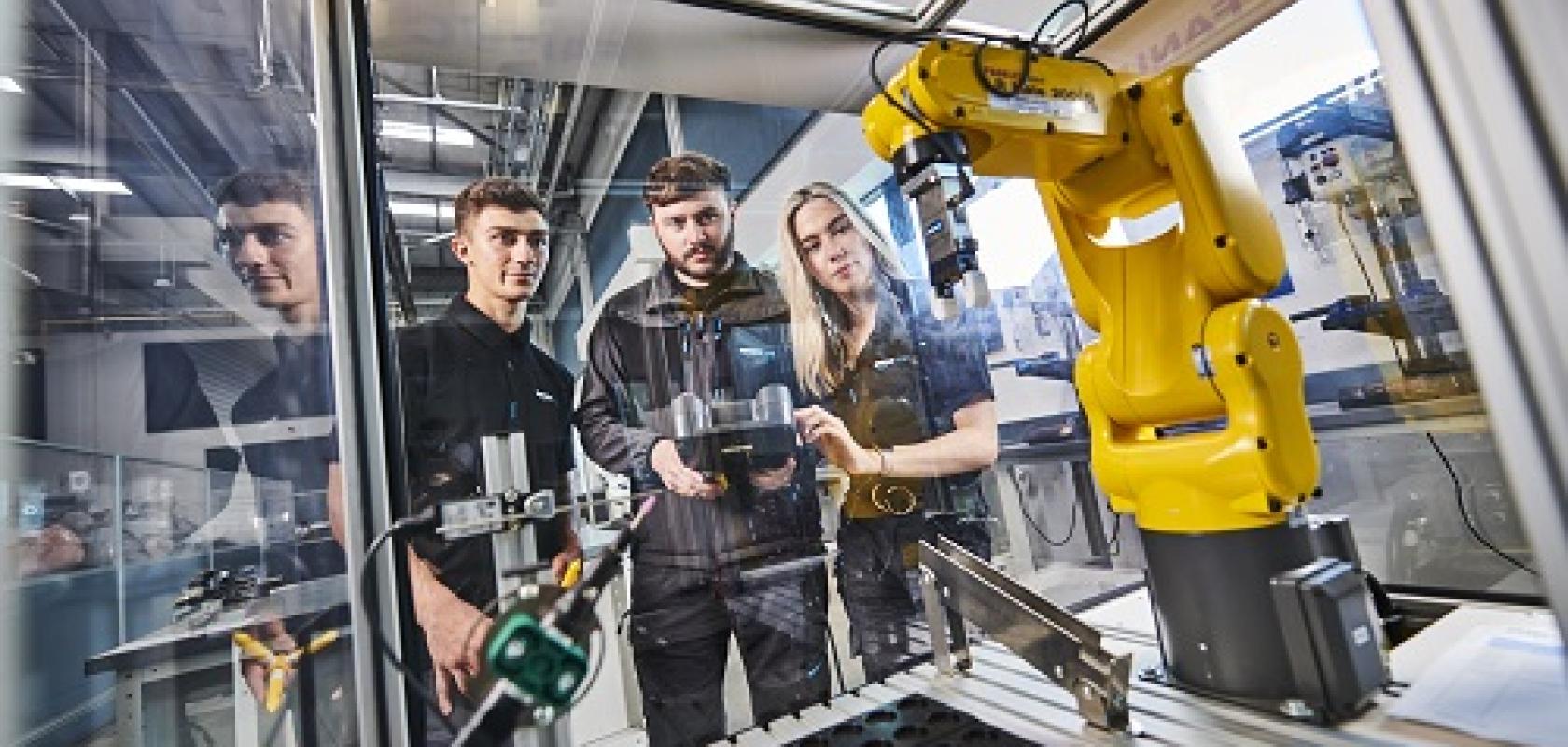Responding to a report on UK adoption of robots and automation, UKIVA’s Neil Sandhu and Allan Anderson argue vision brings similar benefits for productivity
A report entitled ‘Robotics and Automation: A New Perspective’ highlights how speeding up adoption of industrial automation and robotics can lead to dramatic improvements in productivity for the UK manufacturing sector.
Published recently by the Manufacturing Technology Centre, based in Coventry, UK, and the Industrial Policy Research Centre, Loughborough University, the report notes that the UK is 24th in the world for robot density in manufacturing businesses, and lags behind in productivity as a result.
As part of its wide-ranging suggestions for initiatives to address a variety of issues, it calls for a specific emphasis on SMEs to adopt automation and robotics technology. It could equally be argued that increasing the adoption of machine vision in the manufacturing sector would also bring significant benefits.
Machine vision faces many similar challenges to those highlighted for robotics in the report. Not only is it an enabling technology that has a clear role to play in complementing the use of robotics, it also has a much wider use in vision-driven automation of manufacturing processes and ultimately in the realisation of Industry 4.0 and the smart factories of the future. The scope of machine vision embraces a huge range of markets, from electronics to food and beverage, to transport, to sports and entertainment.
Guiding robots
The emergence of collaborative robots, or cobots, and rapid developments in 3D image processing in recent years have paved the way for greater use of vision and robotics, either using a robot to present a component for inspection, or using vision to guide the robot or locate an object for the robot to handle. Massive strides in vision-robot interfaces have made this process much easier.
With continued improvements in camera resolution and advanced image processing, vision-guided robot systems are becoming more sensitive and powerful, enabling robots to recognise shapes, textures and 3D objects faster and more accurately. They bring versatility for pick-and-place, machine tending, assembly, and complex bin-picking. The use of vision enables intelligent, real-time decisions to be made on behalf of an automation system. These advances mean fewer human overrides, vastly improved productivity and fewer product recalls.
While vision can enhance the role of robotics in automation it also has a significant role to play in its own right. This might be inspection for quality control in manufacturing, but also vision measurements can be directly linked into statistical process control methods. By analysing trends in measurements, interventions can be made to adjust the process before any out-of-tolerance product is produced.
In addition, a vision system can capture more information than any other aspect of the production line and generate much larger quantities of data than other sensors. For example, a line scan camera with a 16k sensor operating at 120kHz line rate produces data at 2GB/s. These sorts of data volumes can be processed using the big data analysis techniques that will be embodied in smart factories of the future under the umbrella of Industry 4.0.
Communication between all of the component parts and machines is a critical requirement for Industry 4.0 in order to allow data transfer and sharing. The continuing development of the machine vision companion specification for the platform-independent OPC UA open standard for machine-to-machine communications is providing a gateway for the inclusion of vision in the Industry 4.0 approach. There’s also an OPC UA robotics companion specification.
Demystifying vision
Machine vision is established and versatile, with a multitude of building blocks. However, it is this very versatility that fuels the misconception that it is some sort of black art that can only be handled by vision specialists.
Rather like the world of robotics there is a need to develop skills and further educate the various markets to show what is possible using vision. A variety of initiatives are required in order to address this. One small step has been the emergence of out-of-the-box vision solutions designed to meet specific application requirements, such as for label inspection or PCB assembly inspection, or even out-of-the-box 3D vision-guided bin picking solutions.
While efforts to demystify vision technology are important, an additional approach would be to incorporate an understanding of vision capabilities and how to use them as a part of the engineering skill set so that engineers of the future are ‘vision aware’.
UKIVA members frequently report that it is difficult to recruit new engineers into the industry with the right mix of vision knowledge and engineering skills despite the fact that there are many computer vision courses offered by UK universities. In an ideal world there would be a formal vision apprenticeship, run by an independent organisation that could provide an alternative route into the industry for those not pursuing a university education. These vision apprentices would emerge from their training equipped with the skills needed to progress into industry.
Finding a way to establish, administer and fund such a scheme dedicated to vision, however, continues to be a major challenge. Some help is available through PPMA Best, an independent charitable trust, funded by the Processing and Packaging Machinery Association.
PPMA Best seeks to encourage young people to enter and develop a career in engineering in the processing, packaging, robotics, automation and industrial vision supply industries, through education, training and support. Some UKIVA members have used the resources offered by PPMA Best to introduce school students to vision technology as a potential career path, through Science, Technology, Engineering and Maths (STEM) one-day workshops. These STEM days have been held with groups of Year 10 students at a number of schools and have been very well received, with many students expressing an interest in attending follow-up work experience placements.
In addition, a prime objective of UKIVA is to promote the use of machine vision technology throughout industry and education.
Funding the dream
Faced with the realities of Brexit and the post pandemic labour and skills shortages throughout industry, machine vision and automation can offer real-world solutions, but that requires investment. Help from the government is available until 31 March 2023 through the super-deduction scheme (https://www.gov.uk/guidance/super-deduction), designed to encourage firms to invest in productivity-enhancing plant and machinery assets that will help them grow. This scheme allows companies to cut their tax bill by up to 25p for every £1 they invest. The wider objectives of improving education and widening vision skills require a much greater investment in basic infrastructure.
Neil Sandhu and Allan Anderson are the UK Industrial Vision Association’s chair and vice chair respectively.
--
Report calls for support for automation adoption
Speeding up adoption of industrial automation and robotics can lead to dramatic improvements in productivity, according to a new report published by experts at the Coventry-based Manufacturing Technology Centre (MTC) and the Industrial Policy Research Centre, Loughborough University.
Robotics and Automation: A New Perspective says that the slow uptake of robotics among British manufacturers, and a reluctance to invest in automation, has contributed to the country's vanishingly small improvements in productivity in recent years.
The report, with experts from a wide range of fields contributing opinions and recommendations, calls for a renewed emphasis on the need to improve productivity through the use of automation, with manufacturers, research organisations, equipment suppliers and the UK government working together to help businesses improve their performance through the intelligent use of automation. The report also stresses the importance of independent advice to new users, particularly in the SME supply chain.
In the foreword to the report, Dr Clive Hickman, chief executive of the MTC, said: ‘While the UK was traditionally a leader in world manufacturing, our productivity has been surpassed by other countries and, if ignored, this gap will continue to grow. It is necessary to address the opportunities available within manufacturing to get back on top form and make advances available for businesses across the UK.’
Mike Wilson, the MTC's chief automation officer, said that the pandemic had exposed weaknesses in the UK's extended supply chains leading to a recognition that there was a need to increase the resilience of UK manufacturing by increasing local content and reshoring production capacity.
He said: ‘A significant expansion of manufacturing capability cannot be achieved using the current methodologies, which are largely based on manual labour and obsolete equipment. The Made Smarter Review identified that the application of automation and robotics in UK industry could contribute £183.6 billion over the next decade. The solutions are available and proven. The challenge in the UK is adoption, and also the education of the finance community so they understand and support investment.’
The report calls for more support for UK businesses to help them with adoption at every stage, from identifying opportunities, getting workforce buy-in, selecting suppliers, ensuring they have the right skills, and implementing solutions. It also calls for knowledge-sharing across industry and the automation supply chain in order to develop, demonstrate, test and de-risk affordable and deployable automation, targeting those UK manufacturers who have under-invested in the past.
Better training is also called for, particularly short courses which don't take key people out of the business for long periods of time.
The report also calls for a specific emphasis on SMEs to adopt automation and robotics technology, possibly through an extension to the Made Smarter programme. It also recommends stronger networks, specifically for robots and automation, to encourage more cooperation and communication, to share knowledge and expertise, and to represent the sector to other parties, including the UK government.
The Manufacturing Technology Centre aims to provide a competitive environment to bridge the gap between university-based research and the development of manufacturing solutions. The report can be downloaded here: https://www.the-mtc.org/media/bdba0ls0/automation-and-robotics-research…


